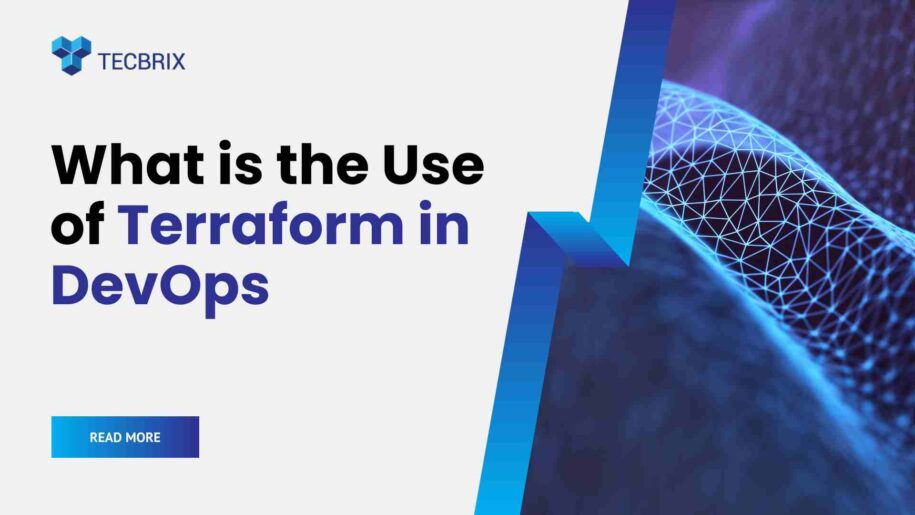IaaC of Infrastructure-as-a-code is one of the primary building blocks of DevOps. By leveraging infrastructure or an entire platform like a code, DevOps experts can handle some of the mundane tasks without putting much effort. The incredible utilization of IaaC makes DevOps and Terraform a perfect match for each other. It makes Terraform a critical framework to fulfill some core requirements of DevOps processes.
What makes Terraform DevOps one of the most opted options despite the presence of some other vital frameworks like Ansible, Microsoft Azure, etc.? This blog post will help you discover why Terraform DevOps is so important and how Terraform is adding value to the DevOps culture. Let’s discover this in detail.
What is Terraform in DevOps?
If you are in search of an effective source to develop, change, or version your infrastructure using Terraform in DevOps is the solution. Terraform is a popular open-source framework introduced by Hashicorp as a cloud-native IaaC utility based on HCL (Hashicorp Configuration Language). The most significant feature of Terraform is its support to manage some renowned cloud services like Google Cloud Platform and Amazon Web Services. Being a multi-cloud framework it also supports on-premise network infrastructures.
Apart from multi-cloud and on-premise support, Terraform also helps in managing and integrating third-party utilities with any cloud service. These 3rd party utilities can be any other cloud-native framework or application (either private or public), SaaS, independent networks, or any other platforms.
Implications of Using Terraform in DevOps
To get a clear insight into how DevOps & Terraform work in close collaboration with each other, we need to discover how Terraform serves as IaaC to support DevOps operations. Using Terraform as IaaC DevOps engineers can seamlessly develop and manage their entire framework using two basic features of IaaC, namely
- Configuration files
- Version control
Terraform in DevOps allows the parsing and translation of code into the API to develop communication with the main cloud service. The process activates when a command is forwarded to implement or execute on the network either on-premise (on a database) or cloud (on a load balancer). Another remarkable feature of Terraform is its open-source framework that enables the developers to leverage a high degree of scalability in terms of adding third-party extensions.
The Two Primary Components of Terraform are:
- Terraform Code
- Terraform Plugins
1. Terraform Code
It helps in integrating all the resources, their EXE files, resource graphs, UI states, and file configs like JSON, YML, etc. Terraform is developed in GO programming language as binary files used to communicate with external resources and plugins. Binary files allow the direct execution of files without compilation. The communication is carried out by RPC (Remote Procedure Calls) which is a communication protocol to call a service request from remotely existing servers or applications.
2. Terraform Plugins
They help in defining the resources and their accessibility for particular services. It also helps in declaring the libraries crucial to call several APIs. Like Terraform Code, Terraform Plugins are also developed in the Go programming language as binary files that don’t require compilation before execution.
What is The Importance of Terraform?
Below are some remarkable aspects & reasons that make Terraform one of the most important frameworks for any cloud-native development or DevOps process.
Managing Infrastructures
If you are searching for a framework that supports and manages a wide array of services, Terraform is the solution. This is one of the most valuable benefits of DevOps Terraform, as it allows you immense flexibility to sustain all your infrastructure requirements and helps in manipulating a range of external resources to address your varying needs.
Transparency
Once you make changes or updates to your infrastructure, Terraform generates a strategic plan for you to help track the state of your infrastructure files and different UI components. This Terraform state file or TFstate helps in keeping a record of all the changes or updates made by users to the infrastructure. The plan it draws for further execution helps you align your changes with the infrastructure configuration.
Streamline Changes & Updates
One of the most remarkable features of the Terraform config files is their declarative characteristic that helps in defining the end goal of changes you made in your infrastructure. It allows you to automate your changes up to the final state without any need to write all instructions for each step.
Using a resource graph, Terraform helps in defining a resource-friendly plan and accelerates the process by parallel execution of non-dependent resources. It helps you improve the efficiency and effectiveness of your DevOps operations and create a compound effect in the long term.
Optimization of Config Files
Modules in Terraform allow you to spare the reusable component of Terraform Config files for later usage. It saves both time & resources and enables you to optimize your DevOps processes. You can search for built-in modules in your Terraform registry or write your customized modules as per your requirements.
Control Access & Collaboration
The source control system in Terraform allows you to define authorization and authentication rules for the shared state and sensitive data. It also allows you to define user-based or role-based authentication protocols and share models or services with different users having access to the private Terraform registry.
Conclusion
Terraform DevOps crossover has proved to be a most valued combo for a range of advantages and aspects discussed in this blog post. Every single feature, utility, or support offered by Terraform is intended to strengthen Terraform’s DevOps culture.
With rich collaboration, state tracking, secure access, multi-platform supports, and a variety of customization options, Terraform DevOps is becoming a new norm in the tech industry. With its flexible, open-source, and declarative framework Terraform is one of the perfect infrastructures for the DevOps processes with its popularity increasing day by day.


